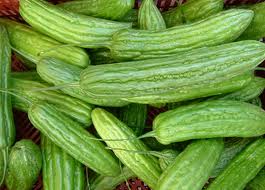 We enjoy the nutritious benefits of most members of the gourd family – watermelon, cantaloupe, and cucumber – yet few of us are familiar with the most bitter, and thereby the most beneficial, gourd of all: bitter melon. Also known as balsam pear, bitter melon resembles a cucumber with bumpy, warty skin. According to The Encyclopedia of Healing Foods, a cup of bitter melon contains 23 calories; it is also an excellent source of vitamins B, C, and E, folic acid, zinc, fiber, magnesium, and contains twice the potassium of a banana. Studies have shown that it lowers blood sugar, combats in vitro viral activity (HIV infections and herpes), and helps fight cancer, especially leukemia.
We enjoy the nutritious benefits of most members of the gourd family – watermelon, cantaloupe, and cucumber – yet few of us are familiar with the most bitter, and thereby the most beneficial, gourd of all: bitter melon. Also known as balsam pear, bitter melon resembles a cucumber with bumpy, warty skin. According to The Encyclopedia of Healing Foods, a cup of bitter melon contains 23 calories; it is also an excellent source of vitamins B, C, and E, folic acid, zinc, fiber, magnesium, and contains twice the potassium of a banana. Studies have shown that it lowers blood sugar, combats in vitro viral activity (HIV infections and herpes), and helps fight cancer, especially leukemia.
Bitter melons are usually available at local farmers markets and from Asian grocers from April through September, though they are best harvested and enjoyed during the Indian summer of September and October. Ayurveda teaches that the bitter taste (comprised of the elements air and ether) has cooling, cleansing, drying, and alkalizing effects, and that bitter foods detoxify and tone the organs, especially the liver. Traditionally, bitter melon is used to treat inflammatory conditions like hypertension, psoriasis, cough, fever, and digestive problems like constipation. In Ayurveda, bitter melon is also beloved for its ability to help balance blood sugar levels.
Choose bitter melons that are firm, yellowish green, and with a biting flavor, like an amped-up green bell pepper. Refrigerate them and keep separate from apples, pears, and other ethylene-producing items which induce ripening. Left to ripen, they become spongy, turn yellowish-orange, and taste excessively bitter. If left in the heat, over-ripe bitter melons may burst to reveal orange flesh with sticky, bright red seeds inside.

Nutrition References:
- The Encyclopedia of Healing Foods by Michael Murray, N.D. 2005, p 169 – 172
Two notes of caution: for pregnant women – bitter melon induces menses and stimulates the uterus, which could cause preterm labor. For diabetics taking hypoglycemic drugs like Metformin, dosage may need to be altered, given the gourd’s blood sugar-lowering effects. For more information, please refer to Encyclopedia of Healing Foods.
Red Jen Ford is a Certified Holistic Health Coach, Yoga Instructor and Seasonal Eating Expert. Jen teaches her clients the benefits and simplicity of eating local, sustainably grown food. Enjoy more of her dishes in her seasonal recipe booklets or online course, Simply in Season – Fall Recipes to Celebrate Healthy, Easy Seasonal Food. Redjenford.com
Red Jen Ford is a Certified Holistic Health Coach, Yoga Instructor and Seasonal Eating Expert. Jen teaches her clients the benefits and simplicity of eating local, sustainably grown food. Enjoy more of her dishes in her seasonal recipe booklets or her online course, Simply in Season: Recipes to Celebrate Healthy, Easy Seasonal Food.
